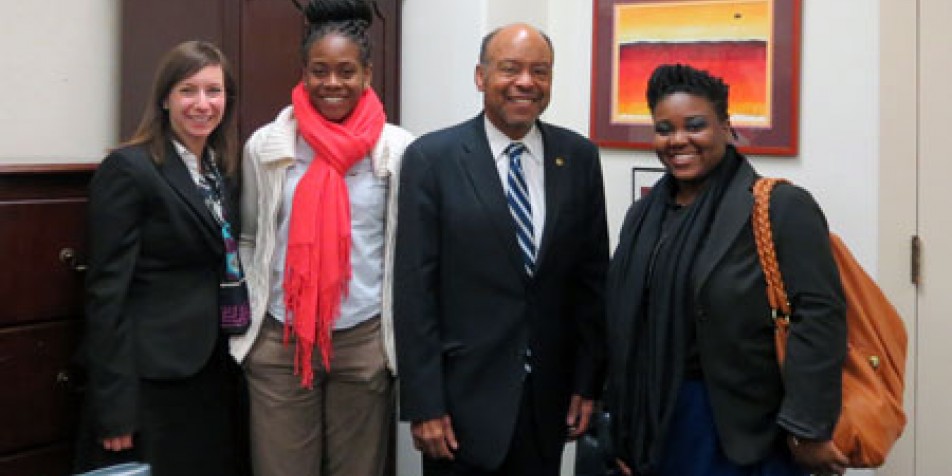Welcome to National Foster Care Month!

Above: Juvenile Law Center Equal Justice Works Fellow (sponsored by Greenberg Traurig, LLP) Kate Burdick (far left) with Breonia (l) and Megan (far right), two of our Youth Fostering Change Youth Advocates, meet in Harrisburg, PA with State Rep. James Roebuck, Jr., to discuss how to better meet the educational needs of foster youth.
May is National Foster Care Month, and the theme this year is "Supporting Youth in Transition." All month long, we'll be spotlighting important issues for older youth in foster care and providing concrete steps you can take to support them.
While the number of youth in care has decreased in recent years, the percentage of older youth (ages 13 and up) in care continues to rise. Nationally, between 2000 and 2010, more than 260,000 older youth transitioned from foster care without achieving permanent family connections. As we write, nearly 30,000 young people annually transition from care lacking those connections.
As a consequence, these youth face great challenges as adults; they need and deserve the support, guidance, and opportunities most non-foster youth have. Without support, far too many end up homeless, alone, and without the education and skills they need to become successful adults. They deserve better.
Congress in 2008 passed the Fostering Connections to Success and Increasing Adoptions Act. The Act provided incentives to states that increased opportunities for youth to remain in foster care between ages 18 and 21.
Pennsylvania is among the states that have implemented the Fostering Connections Older Youth Extensions. In July of 2012, Acts 80 and 91 were enacted to allow more youth to remain in care past 18 and to re-enter care before turning 21 if they need help. Adoption and kinship/guardianship subsidies were also extended to age 21 to promote the achievement of permanency and family for older youth.
Act 80 and 91 serve as powerful tools to support youth in transition. The new laws are an excellent start. However, to reduce the number of youth aging out of foster care without permanency while increasing positive education, employment, and health care outcomes, we must do more than merely extend foster care. We must also improve and change it so that it works for young adults. No one understands this better than the young people in foster care themselves. Throughout this month, we will be sharing their insights and highlighting the following issues that are central to supporting youth in transition:
- Youth engagement must be embedded at all levels of child welfare policy and practice: Youth and young adults must be actively engaged in the decisions in their individual cases as well as in larger policy discussions.
- Teens should be treated like teens: Youth in care deserve the same treatment and opportunities as their peers. Rules, expectations, and goals must reflect those of teens and young adults in general.
- Flexible, age-appropriate placement options must be developed for older youth: In addition to increasing the number of family placements for older youth, the child welfare system must provide more age-appropriate placement options to allow youth to practice and develop the skills they need for adulthood. Older youth should have more independent and flexible settings while they still have the safety and guidance of the system.
- Secondary and post-secondary educational success must be prioritized: A quality education is one of the most important components of a successful transition plan. We must make sure that older youth have their educational needs met and that high expectations are communicated and meaningfully supported.
- Coordinated and multi-system planning must occur with older youth with special needs: Like all youth, youth with special needs must be connected with family and prepared for adulthood. Additional planning and services may be necessary to ensure that special needs youth get what they need and deserve. In addition to making sure that older youth in the system have treatment and services in the least restrictive, community-based setting, we must make sure that the systems that serve these youth when they are younger than 21 coordinate with adult systems. This must be done to ensure that continuous, quality care is provided, as funding and eligibility criteria change for special needs youth as they age out of the child welfare systems.
More Information
National Foster Care Month official website
Jim Casey Youth Opportunities Initiative's "Success After 18" Campaign
Pennsylvania Partnerships for Children's report, Growing Up and Aging Out
"Life After Foster Care: Our Stories," a video by Youth Fostering Change, Juvenile Law Center's engagement program for youth currently or formerly in the child welfare system